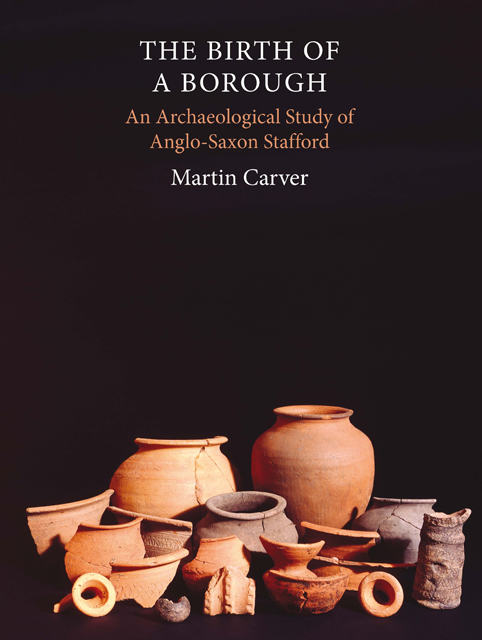Book contents
- Frontmatter
- Contents
- List of Illustrations
- Preface
- Acknowledgements
- Abbreviations
- 1 Questions
- 2 Digging up Stafford: Evaluation and Design
- 3 Seven Windows on Early Stafford: The Principal Investigations
- 4 Æthelflæd’s Town
- 5 Aftermath: Norman and Medieval Stafford
- 6 Anglo-Saxon Stafford in Context
- Digest A1 Archaeological Interventions at Stafford to 1988
- Digest A2 Dendrochronological and Radiocarbon Dates
- Digest A3 Pottery Seriation
- Digest A4 Key to Pottery Illustrations
- Digest A5 Excavated Structures
- Digest A6 Contents of the Stafford Online Archive: http://ads.ahds.ac.uk/catalogue/archive/stafford_eh_2009
- Bibliography
- Index
5 - Aftermath: Norman and Medieval Stafford
Published online by Cambridge University Press: 17 February 2023
- Frontmatter
- Contents
- List of Illustrations
- Preface
- Acknowledgements
- Abbreviations
- 1 Questions
- 2 Digging up Stafford: Evaluation and Design
- 3 Seven Windows on Early Stafford: The Principal Investigations
- 4 Æthelflæd’s Town
- 5 Aftermath: Norman and Medieval Stafford
- 6 Anglo-Saxon Stafford in Context
- Digest A1 Archaeological Interventions at Stafford to 1988
- Digest A2 Dendrochronological and Radiocarbon Dates
- Digest A3 Pottery Seriation
- Digest A4 Key to Pottery Illustrations
- Digest A5 Excavated Structures
- Digest A6 Contents of the Stafford Online Archive: http://ads.ahds.ac.uk/catalogue/archive/stafford_eh_2009
- Bibliography
- Index
Summary
What happened at the Norman Conquest?
Eadric the Wild (Silvaticus) with men of Cheshire and Wales rebelled against William I and besieged Shrewsbury in 1069. William met them at Stafford and destroyed the uprising, returning the following year to crush the remnants and redistribute the Mercian lands among his own followers. This was a traumatic event that reached deep into everyday life: areas ravaged at the time were still derelict at Domesday, seventeen years later. Stenton comments ‘the operations of 1069–70 were distinguished from ordinary warfare by a deliberate attempt to ruin the population of the affected districts’. We may anticipate that the residents of Æthelflæd's burh would not have been unaffected by the momentous events of the mid eleventh century. Here the intention is to focus on their fate as demonstrated by the archaeology. The first question, What happened at the Norman Conquest?’, will be followed by others: When did redevelopment start? Did Æthelflæd's vision endure? Was there a second hiatus? How far did Stafford continue to embrace the urban idea? In each case I shall refer only to events on or under the ground (Fig. 5.1). Once we have got these right there will be opportunities to paint in broader medieval landscapes, using more expert hands than mine. As was observed in Chapter 3, Stafford town survived, but not at a consistently urban level. This has some implications for both the archaeology and the more general history of the town in Britain, and these will be briefly aired before returning, in Chapter 6, to our main theme: the Late Saxon burh and its context.
In order to construct a narrative archaeologically, and give it some useful historical precision, we draw on three kinds of evidence: stratification, which shows where Late Saxon features, already identified, were succeeded by something new; dendrochronology of timbers where we have them, which gives the first use of a piece of wood to the nearest year; and pottery. Although pottery is hard to date within twenty-five years, it is ubiquitous and therefore labels nearly every event. In Stafford we are fortunate in having a strongly defined sequence. Stafford ware is distinctive in both form and fabric, consisting mainly of orange-coloured jars, pots, bowls, lamps and pitchers (Chapter 4, pp. 76–93).
- Type
- Chapter
- Information
- The Birth of a BoroughAn Archaeological Study of Anglo-Saxon Stafford, pp. 102 - 126Publisher: Boydell & BrewerPrint publication year: 2010



